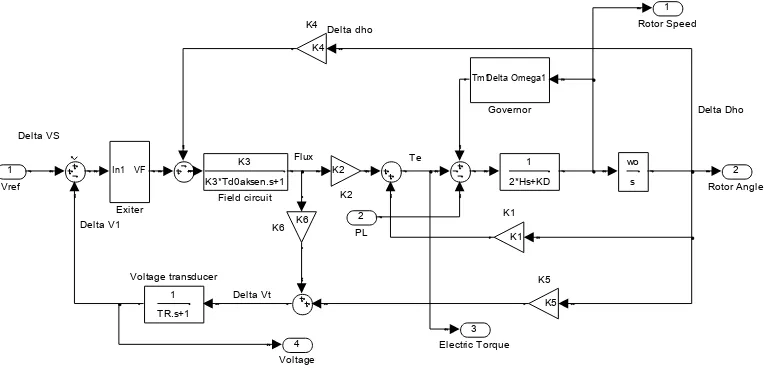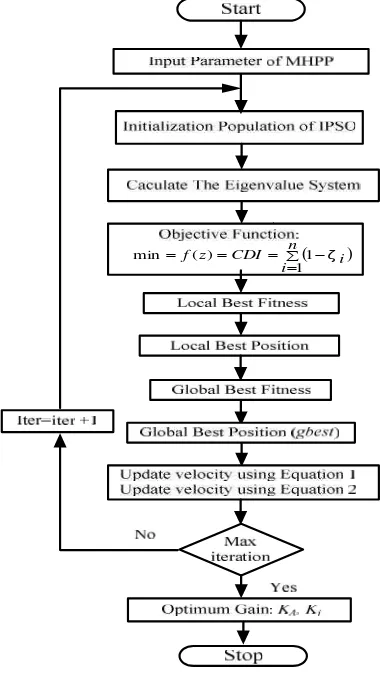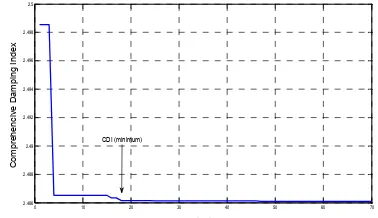accredited by DGHE (DIKTI), Decree No: 51/Dikti/Kep/2010 297
Modeling And Control Of Excitation And Governor
Based On Particle Swarm Optimization For Micro Hydro
Power Plant
Muhamad Haddin1,2, Soebagio2, Adi Soeprijanto2, Mauridhi Hery Purnomo2
1Dep. of Elect. Eng., Universitas Islam Sultan Agung (UNISSULA), Semarang, Indonesia
2
Dep. of Elect. Eng., Institut Teknologi Sepuluh Nopember (ITS), Surabaya, Indonesia
e-mail: [email protected]
Abstrak
Makalah ini menyajikan pemodelan dan kontrol eksitasi melalui automatic voltage regulator (AVR) dan governor melalui automatic generation control (AGC) atau frequency load control (FLC) untuk meningkatkan stabilitas pembangkit listrik tenaga mikro hidro (PLTMH). Tiga bagian utama sistem pembangkitan adalah generator sinkron, eksitasi AVR dan AGC yang dimodelkan secara linear. Generator dimodelkan dengan sebuah mesin yang terhubung ke bus tak terhingga (single machine connected to infinite bus/SMIB) yang dilengkapi dengan AVR dan model linier eksitasi. Kontrol sistem eksitasi dilakukan
dengan mengoptimalkan gain AVR (KA) dan gain AGC (Ki) dengan menggunakan metode improved
particle swarm optimization (IPSO). Tujuan utama dari kontrol gain AVR-AGC adalah untuk menstabilkan frekuensi osilasi dari PLTMH yang terhubung ke bus tak terhingga. Simulasi dilakukan dengan menginputkan fungsi step dengan fluktuasi beban 5% sebagai representasi dari beban dinamik. Hasil simulasi menunjukkan bahwa metode yang diusulkan efektif menaikkan tingkat osilasi redaman elektromekanik pada SMIB dan meminimumkan indeks redaman komprehensif (comprehensive damping index/CDI).
Kata kunci:kontrol eksitasi-governor, pembangkit listrik tenaga micro hidro, PSO
Abstract
This paper presents the modeling and control of the excitation system via the automatic voltage regulator (AVR) and governor system through the automatic generation control (AGC) or frequency load control (FLC) to improve stability on a micro hydro power plant (MHPP). Three main parts of the generation system are synchronous generator, AVR-excitation, AGC modelled linearly. Generator is modelled by a single machine connected to infinite bus (SMIB) which is equipped by AVR and excitation
linear model. Excitation control system made by optimizing the gain of the AVR (KA) and the governor with
the gain of the AGC (Ki). Optimization is done using the method improved particle swarm optimization
(IPSO). The main purpose of setting the gain of the AVR-AGC is to stabilize the oscillation frequency of the MHPP which is connected to an infinite bus. Simulations are conducted by inputting step function with 5% load fluctuations as a representation of dynamic load. The simulation results show that the proposed method effectively raises the level of electromechanical damping oscillations the SMIB by generating the comprehensive damping index (CDI) is minimum.
Keywords: control of excitation and governor, micro hydro power plant, PSO
1. Introduction
MHPPs are generally isolated from grid network. MHPPs have some problem such as storage is very small, the unit cost is high and rapidly affect small changes in the river. The main problem at MHPPs are how to keep the speed constant. Frequency and voltage is an important criterion in power system. Consumers want to sustainable energy, reliable quality and stability system. Stability system can be defined as the tendency of power system to react to disturbances by developing restoring forces equal to or greater than the disturbing forces to maintain the state of equilibrium (synchronism). So that the stability of the power system is maintained, it would require appropriate control strategies.
in: linear model of excitation and governor systems have been written by the linearization method of differential equations that describe the dynamic performance of power systems around the operating point [1-9].
In addition, intelligent control and adaptive control has been applied to control the frequency or control the voltage and frequency based on PSO for the MHPP [10-13]. However, the research resulted high frequency oscillation. The use of optimal control method of AVR-PSS-based differential evolution and imperialist competitive also been investigated with result showed that the settling time is high [14-15]. This paper proposes a method improved particle swarm optimization (IPSO) to optimize the gain of the AVR (KA) on the excitation system and
the gain of the AGC (Ki) to the governor of dynamic stability of power systems. This paper show
that the control proposed method effectively minimizes the oscillation speed of rotor, rotor angle and terminal voltage as showed by the damping, convergence time, overshoot and the minimum error to reach steady state. Optimization purposes using IPSO is to minimize the objective function comprehensive damping index (CDI) for coordination between the AVR and AGC can be set appropriately so that the performance stability of the MHPP for the better.
2. Research Method
Automatic Voltage Regulator (AVR)
AVR function is to keep the generator voltage at fixed nominal value. Model AVR depends on the type of DC current injection source to the excitation system. An important part of the AVR consists of amplifiers, exciter, excitation voltage limiters, generators, and transducers. AVR transfer function can be written as in Equation (1).
( )
( ) 1
R A
c A
V s K
V s sT
(1)
where VR(s), VC(s), KA andTA are the output amplifier, control signal, gain of AVR or amplifier
gain and time constant interval, respectively.
The value of the amplifierKA was determined between 10-400 with a time constant TA has a
value between 0.02-0.1 s. Excitation voltage is limited using a limiter to avoid over excitation or under excitation.
Excitation system modeling used in the MHPP consists of the AVR and the exciter is shown in Figure 1
Figure 1. Model of excitation system with AVR
Automatic Generation Control (AGC)
AGC function is to maintain or restore the system frequency to the desired range [15]. This can be done by adding an integral controller in the load frequency control (LFC), which serves as input to the reference value of the load on the unit operated as governor AGC as shown in Figure (2). The addition of the integral controller intended to set the frequency error in steady state conditions is zero.
1 VF 1
T E.s+1 T ransfer Fcn
Saturati on 1 Saturati on
-K-KA
1
T A.s+1 AVR 1
Figure 2. Model of govenor turbin with AGC
The proposed simulation model is developed as a fourth order machine time constant in order to improve the terminal voltage and frequency deviation responses. With proper modeling of the synchronous machine in the power system, a better understanding of how the machine reacts under small disturbances can be achieved and hence a better power system voltage regulator and governor controllers of the SG can be designed.
Modeling of Synchronous Generator
The overall accuracy of the power system stability is primarily decided by how correctly the synchronous generator (SG) within the system are modeled. Representation of a MHPP can be modeled as a SG with AVR and governor are connected with infinite bus is shown in Figure 3. By using Matlab-Simulink representation of a MHPP can be modeled as a synchronous generator equipped with AVR and governor are connected with infinite bus is shown in Figure 4.
ω
t
V
Figure 3. Representasi of a MHPP connected with infinite bus
Implementation of Improved Particle Swarm Optimization
Particle swarm optimization (PSO) is another evolutionary computation technique developed by Eberhart and Kennedy [16], which was inspired by the social behavior of bird flocking and fish schooling. PSO has its roots in artificial life and social psychology, as well as in engineering and computer science. It utilizes a “population” of particles that fly through the problem hyperspace with given velocities. PSO model consists of a set of particles is initialized with a population of candidate solutions at random. Particles moving through space with a d-dimensional problem to seek new solutions, with fitness f, can be calculated as a determined measuring quality. Each particle has a position represented by the vector-position xi(i is the
index of the particle) and speed (velocity) is represented by the vector velocity vi. Each particle
has so far resulted in the best position (pbest) in vectorxi k
, and the value of the j-th dimension is xij
k
. Vector best position among the compounds (swarm)so far (gbest)is stored in a vector xl, and the value of the j-th dimension isxj
l
. During this time of iteration (t), the particles update the speed of the previous speed with the new speed determined by Equation (2). The new position is determined by the sum of the previous position and the new velocity as shown in Equation (3).
1 1 2 2
( 1) ( ) ( k( ) ( )) ( l( ) ( ))
ij ij ij ij ij ij
2. Calculating thefitnessvalue for each particle
3. From the results of the calculation value of fitness, the best fitness known locally is the best fitness value for each particle and the local best position that is the best position of each particle. The current fitness value is compared to the previous fitness value. If the value is better so the change of the previous particle positions with the current position has a better fitnessvalue and the fitness value becomes the reference of the nextfitness value.
4. Finding theglobal best fitnessvalue, namely a minimum value of thelocal best fitness. 5. Determining theglobal best position. This is obtained by replacing each candidate particle
solutions withlocal best position of particles that meet the requirements of the global best fitness.
6. Updating the velocity and position
7. Repeating steps 2 through 6 to comply with the specified
Figure 4. Linier modeling MHPP with AVR and AGC
A large inertia weight value very well could help in the global search, while the smaller inertia weight facilitates local exploration. Therefore, in practice the use of inertia weight factor value greater during the initial exploration and decreased gradually in value as the search results in further iterations. The concept of inertia weight to improve the performance of PSO algorithm is given by Equation (4).
max min
It is the current number of iterations andMaxItis the maximum number of iterations. Usually the value of w varies between 0.9 and 0.4.
MHPP linear models equipped with AVR and AGC combined and converted into the Equation (5) and (6). By using the matrix A of the linear model of the power system as a whole, the eigenvalue in Equation (7) can be evaluated. Optimization gain of AVR (KA ) and AGC (Ki)
by calculating the eigenvalue of the matrixA. Eigenvalue power system can be shifted to the negative real by finding the maximum value of damping ratio for each eigenvalue. Search the maximum value of damping ratio equal to find the minimum value of the comprehensive damping index (CDI). Equation (8) is a formula of the CDI is used as the fitness function of the particle in the optimization process. By minimizing Equation (9), eigenvalue power system can be shifted to the negative real.
matrix system, matrix input, matrix output,i-th eigenvalue, real part of thei-th eigenvalue, real imaginer part of thei-th eigenvalue and damping ratio of thei-th, respectively.
Optimization gain of AVR (KA) and AGC (Ki) using the method IPSO wherein the method
is also used CDI as fitness and gain value allowed as a delimiter in the optimization process as shown in Eq. (10). In addition to the gain, the damping ratio is also used as a limiting factor. CDI is a function of z,za matrix of rows and the elements is the gain of the AVR (KA) and AGC (Ki).
At IPSO method, z is named as the position of particles with d-dimensional problem space. Optimization algorithm is shown in Figure (5).
information on the dynamic performance of the system by deviation of rotor speed, rotor angle and voltage at MHPP. Figure (6) shows that the global minimum particle fitness is achieved at the 18th iteration. This shows that the minimum value of the CDI can be achieved in the 18th iteration. Figure (7)-(9) showed that the response of the rotor speed deviation, rotor angle and voltage at MHPP.Figure (7)-(9) showed that the use of IPSO algorithms for optimizing the gain of the AVR and AGC produced a more stable system with a damping oscillation during the disturbances that occur the better. Comparison of the comprehensive damping index (CDI), the eigenvalue, overshoot and settling time shown in Table (1)-(3).
Table 1.Comprehensive damping index(CDI)
Methods CDI
Without AGC 3.9796
With AVR-AGC 5.6830
Table 3.Settling time(second)
Open Loop With AVR-AGC AVR-AGC With IPSO
ω
2.1 1.9 1.8
δ
2.67 2.39 2.141
t
V
2.064 1.759 1.513
Optimization the gain of AVR and AGC using the IPSO produce a minimum value of the CDI when compared with the CDI without coordination. Table 1 shows that the CDI value decreased significantly to which shown that better stability. Table 2 shows that the decrease in load angle overshoot on the open-loop conditions and using the PSS-AVR based MPSO is 6.7%, while using the PSS-AVR and PSS-AVR based MPSO is 3.7%. Table 2 shows that the difference in settling time reduction of rotor angle in a state open loop using the PSS-AVR based MPSO is 24% and using the PSS-AVR with PSS-AVR based MPSO is 11.6%. Thus the results are shown in Table (1-3) shows that the stability of the power system is getting better.
n
i i
CDI z f
1 1 )
(
min ζ
Figure 6. Graphics CDI as a function of iteration Figure 7. Response of speed deviation
Figure 8. Response of load angle deviation Figure 9. Response of voltage deviation
4. Conclusion
Improved Particle Swarm Optimization (IPSO) can be applied to modeling and control of the excitation system and governor on the generator through the optimization of the gain of AVR (KA) and AGC (Ki). Tuning method of control coordination is able to reduce the CDI of MHPP.
CDI value of the minimum can be reached at 18th generation. Control method based PSO is able to provide the best results by increasing the stability of power system during a disturbance and more quickly achieve a stable condition than before the installation of AGC and without coordination as well as open loop system.
Appendix
Table 4. Parameter of MHPP
Parameter Value Parameter Value Parameter Value Parameter Value Parameter Value
C2(Social constants) 0.75
wmax 0.4
wmin 0.9
References
[1] M Hanmandlu, H Goyal. Proposing a New Advanced Control Technique for Micro Hydro Power
Plants.Electrical Power and Energy Systems. 2008; 30: 272-282.
[2] M Hanmandlu, H Goyal, DP Kothari.An Advanced Control Scheme for Micro Hydro Power Plants.
International Conference on Power Eletronis, Drives and Energy Systems.2006; 06:1-7.
[3] CD Vournas, G Papaionnou. Modeling and Stability of a Hydro Plant with Two Surge Tanks. IEEE
Transaction Energy Conversion. 1995; 10 (2): 368-375.
[4] Park H Gao, C Wang. Effect of Detailed Hydro Turbine Models on Power System Analysis. Power
Systems Conference and Exposition. 2006:1577-1581.
[5] F Hong Qing, S Zu-yi. Modeling and Simulation of Hydraulic Transients for Hydropower Plants.
IEEE/PES Transmission and Distribution Conference & Exhibition.China. 2005.
[6] W Shu-qing, L Su-yi, Z Zi-peng. Research on the Improved Learning Algorithm of FNNC for the
Control of Hydraulic Turbine Generating Units. Proceedings of the Sixth International Conference on
Machine Learning and Cybernetics, Hong Kong. 2007: 617-622.
[7] Gagan Singh, DS Chauhan. Simulation and Modeling of Hydro Power Plant to Study Time
Response during Different Gate States. International Journal of Advanced Engineering Sciences
and Technology. 2011; 10 (1): 42-47.
[8] TR Shyama, . Satheesh Kumar, V Shanmugasundaram. Design of FGSPI Controller Based
Combined LFC and AVR of Two Area Interconnected Power Generating System, International
Journal of Engineering and Advanced Technology. April 2012; 1(4).
[9] Ibraheem, Omveer Singh. Current Philosophies of Intelligent Techniques based AGC for
Interconnected Power Systems, Canadian Journal on Electrical and Electronics Engineering.
September 2012; 3(7): 390-397.
[10] Ibraheem, Omveer Singh. Design of particle swarm optimization (PSO) based automatic generation
control (AGC) regulator with different cost functions,Journal of Electrical and Electronics Engineering
Research. November 2012; 4(2): 33-45.
[11] A Soundarrajan, S Sumathi. Particle Swarm Optimization Based LFC and AVR of Autonomous
Power Generating System.IAENG International Journal of Computer Science.February 2010; 37(1).
[12] J Usman, MW Mustafa, JJ Jamian, G Aliyu. Damping Low Frequency Oscillations In Power Systems
Using Iteration Particle Swarm Optimizations. ARPN Journal of Engineering and Applied Sciences.
November 2012; 7 (11): 1379-1386.
[13] M Suguna. Damping of Low- frequency Oscillations Using Swarm Optimized Controller for SMIB
System, International Journal of Engineering and Innovative Technology (IJEIT), April 2012; 1(4):
252-258.
[14] H Hosseini, Behrooz Tusi. A Novel Method for Designing PSS-AVR by Imperialist Competitive
Algorithm (ICA) for three-area AGC System, Journal of World’s Electrical Engineering and
Technology.2012; 1(1): 43-50.
[15] B Selvabala, Devaraj. Co-Ordinated Tuning Of AVR-PSS Using Differential Evolution Algorithm.
IEEE IPEC. 2010; 439-444.
[16] R Ebenhart, Kennedy. Particle Swarm Optimization. Proceeding IEEE Inter Conference on Neural



